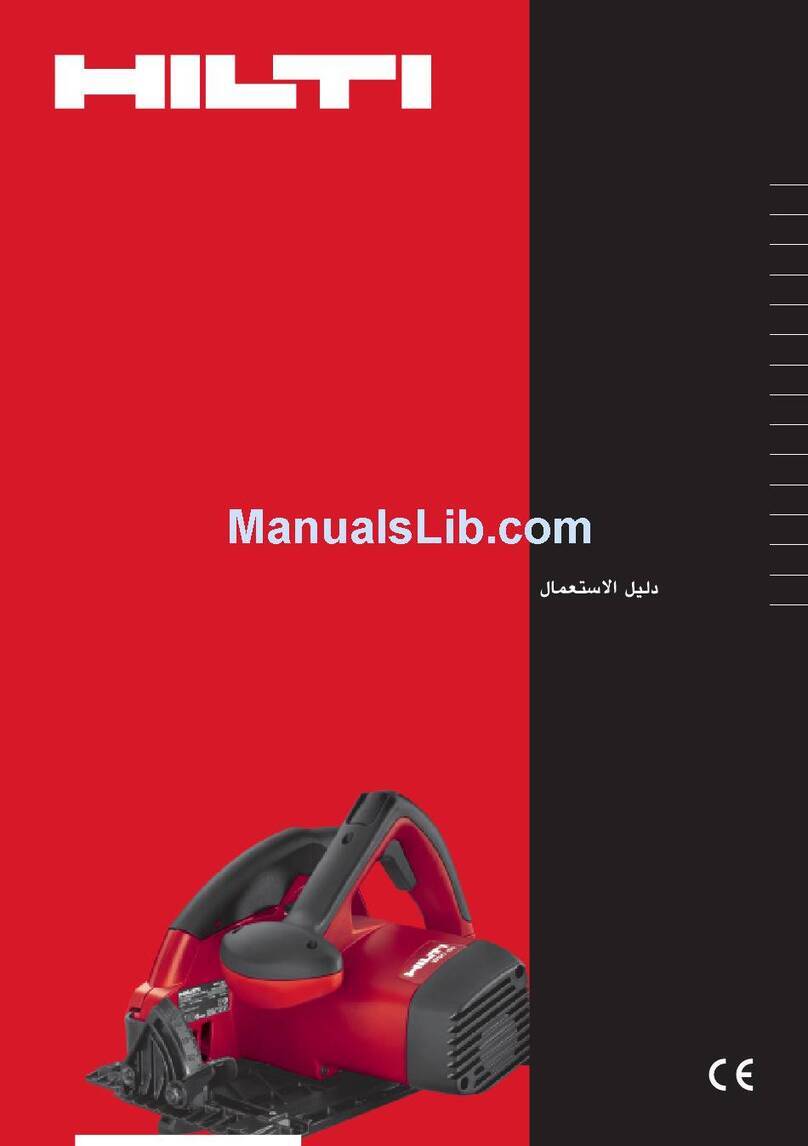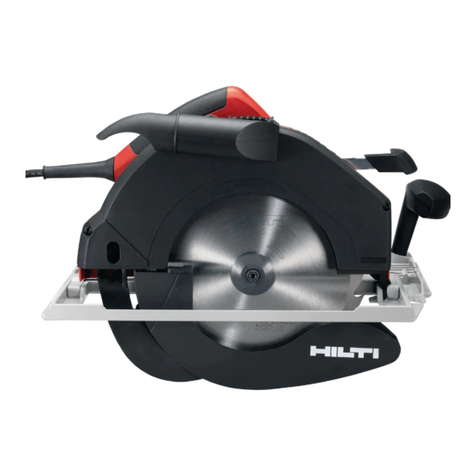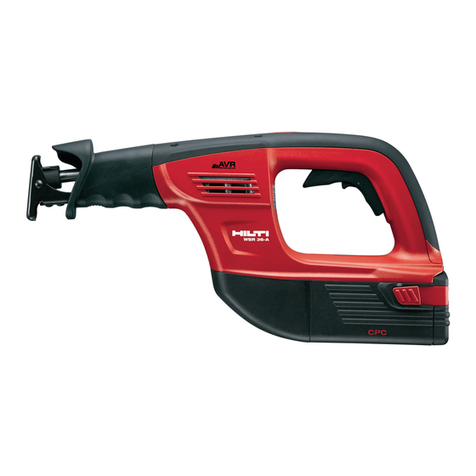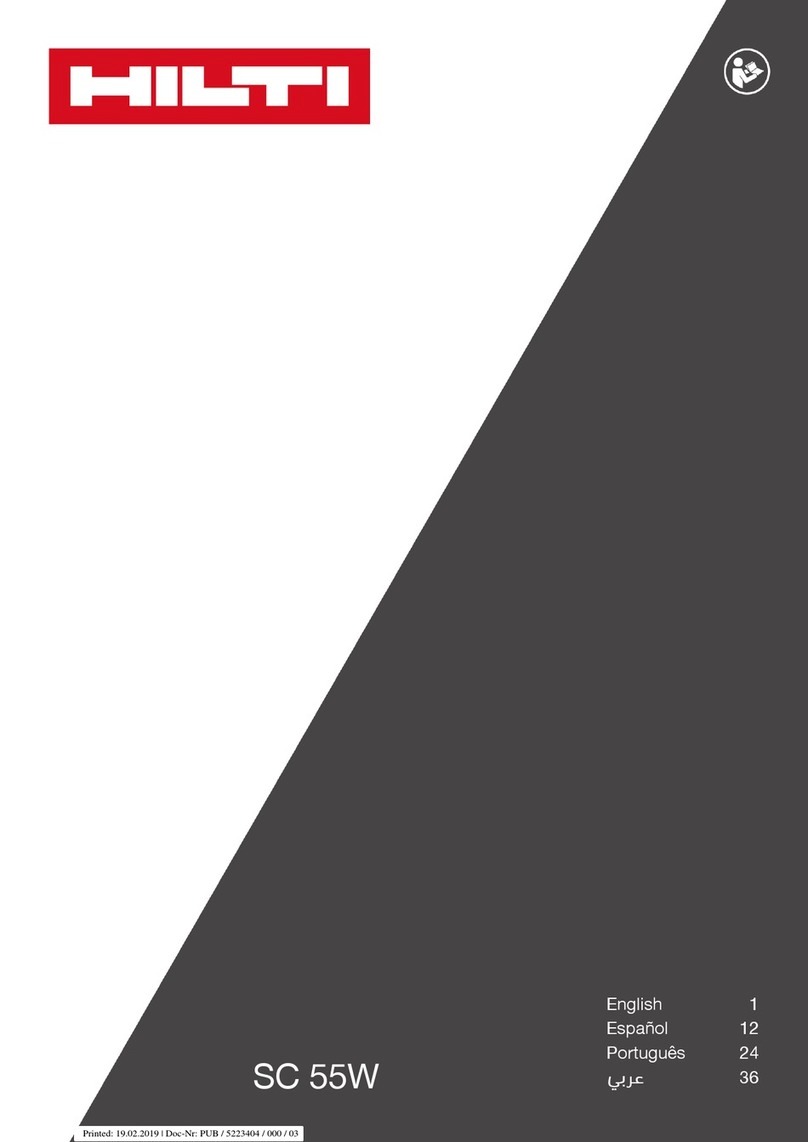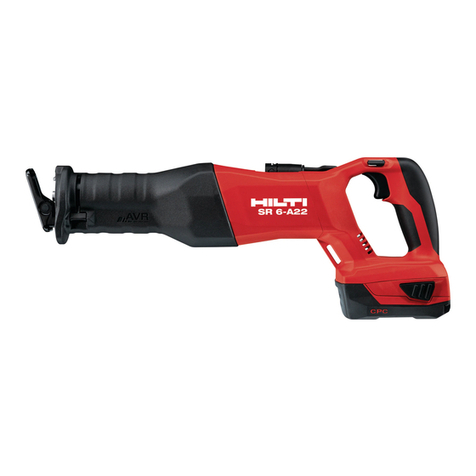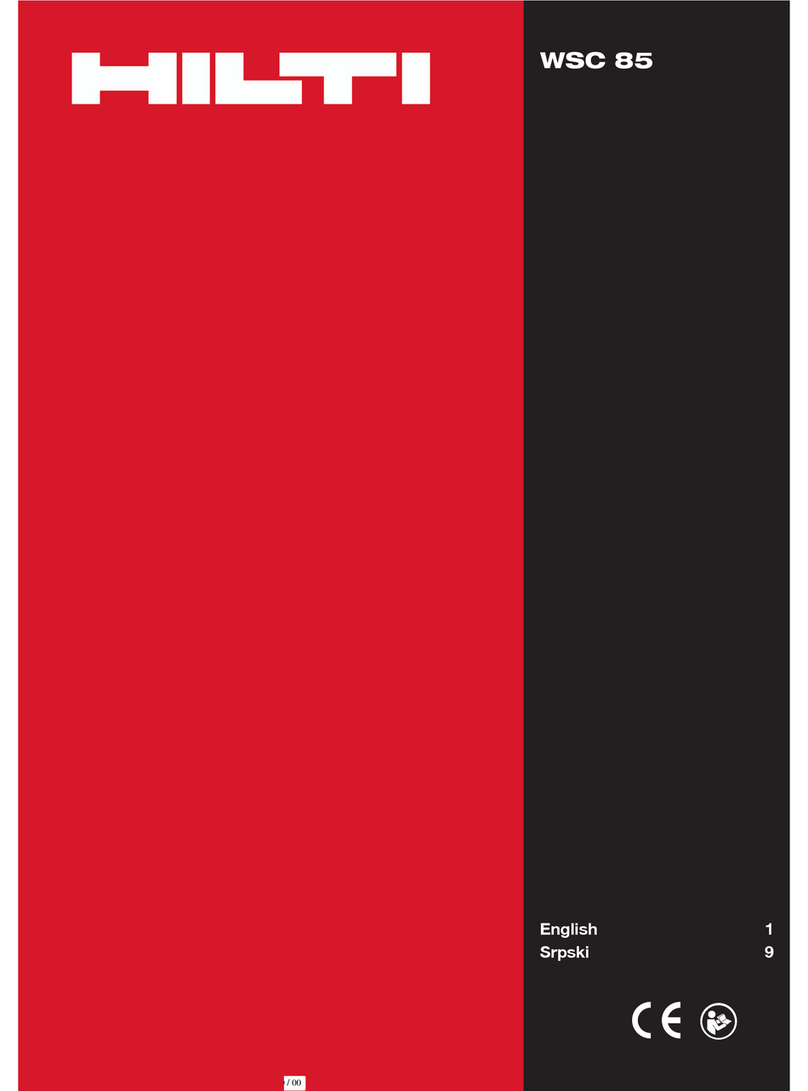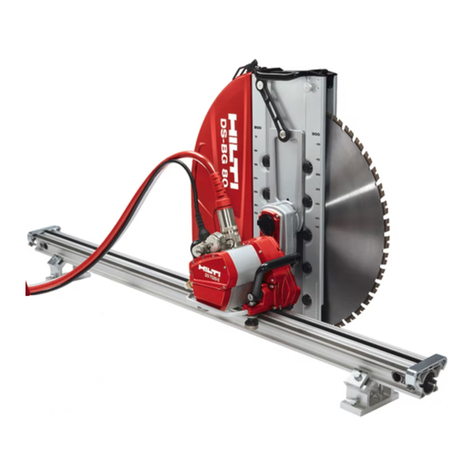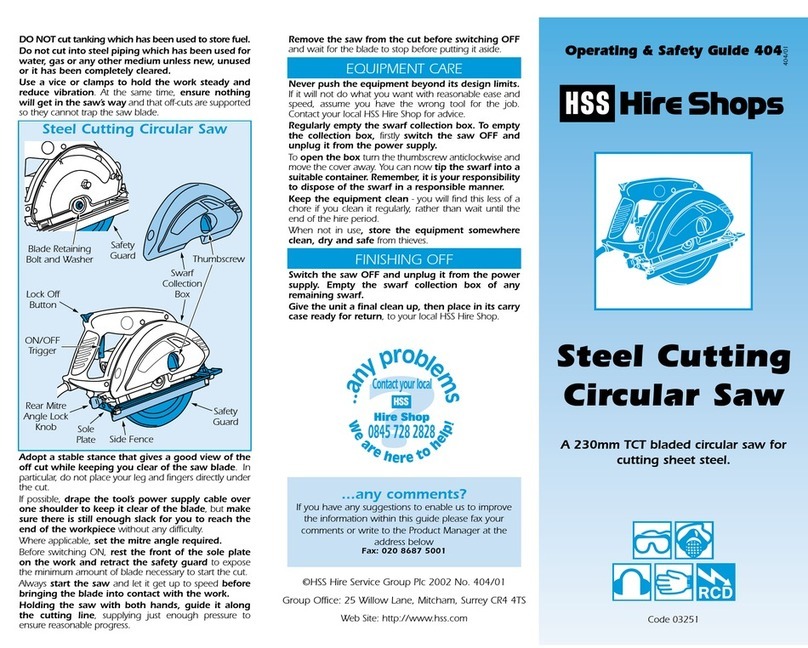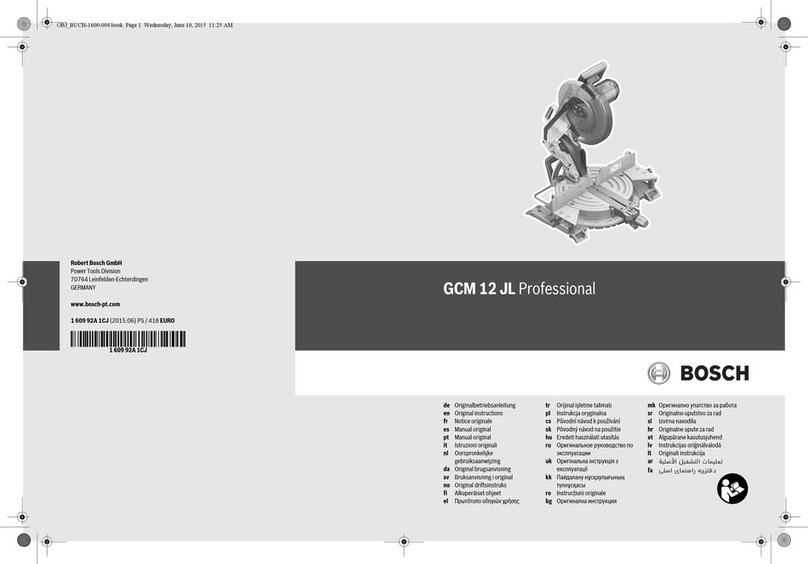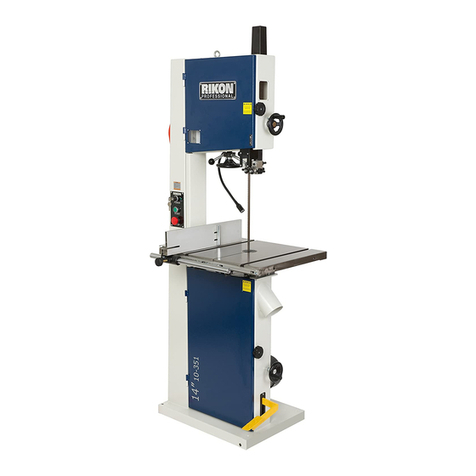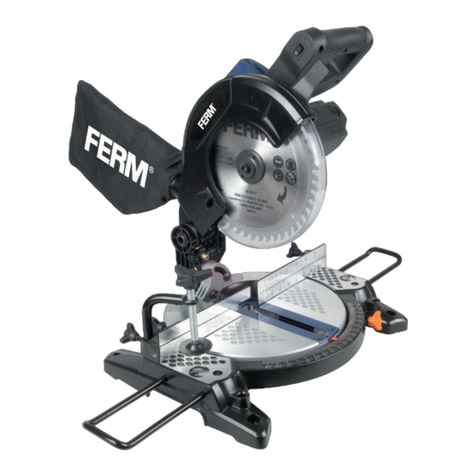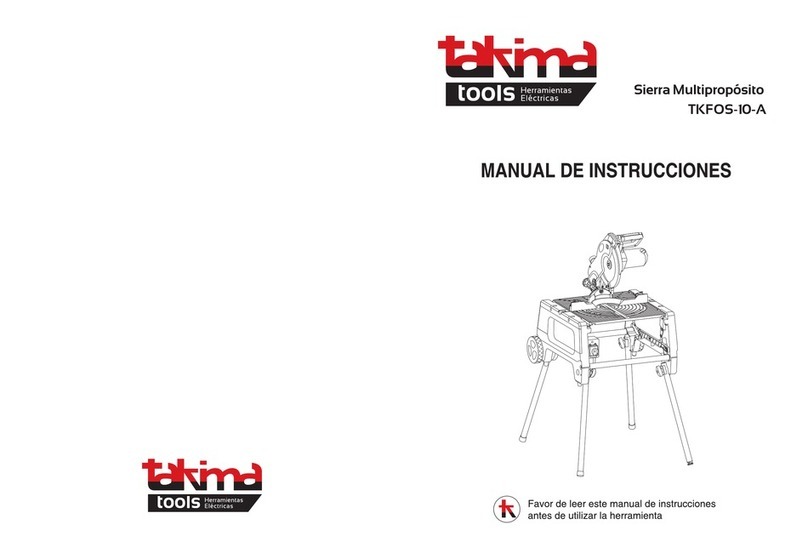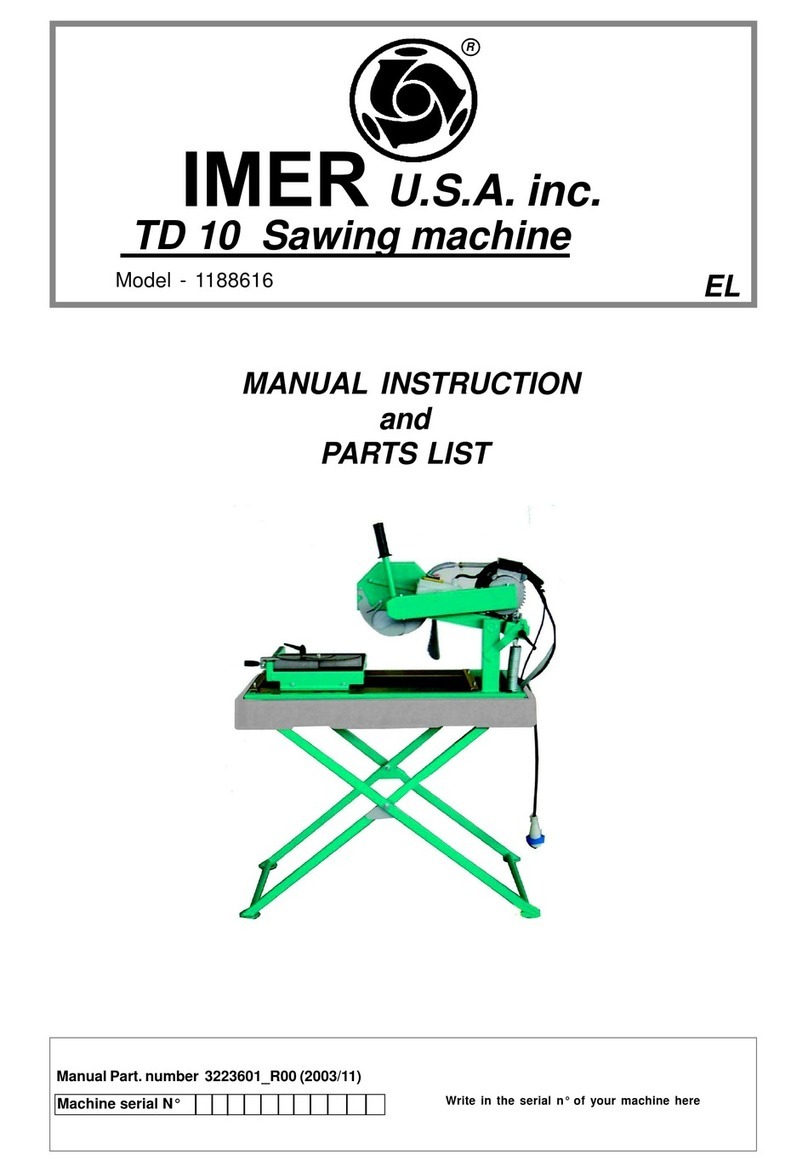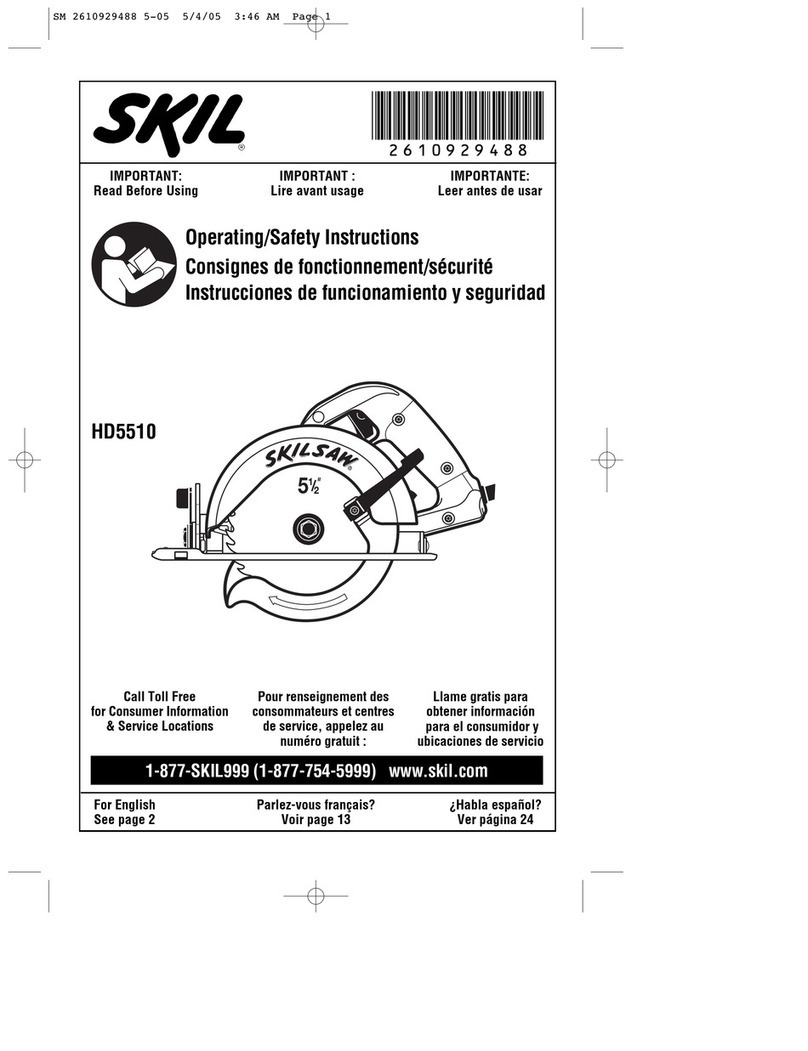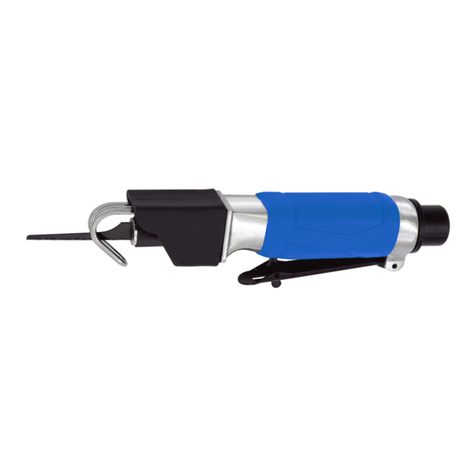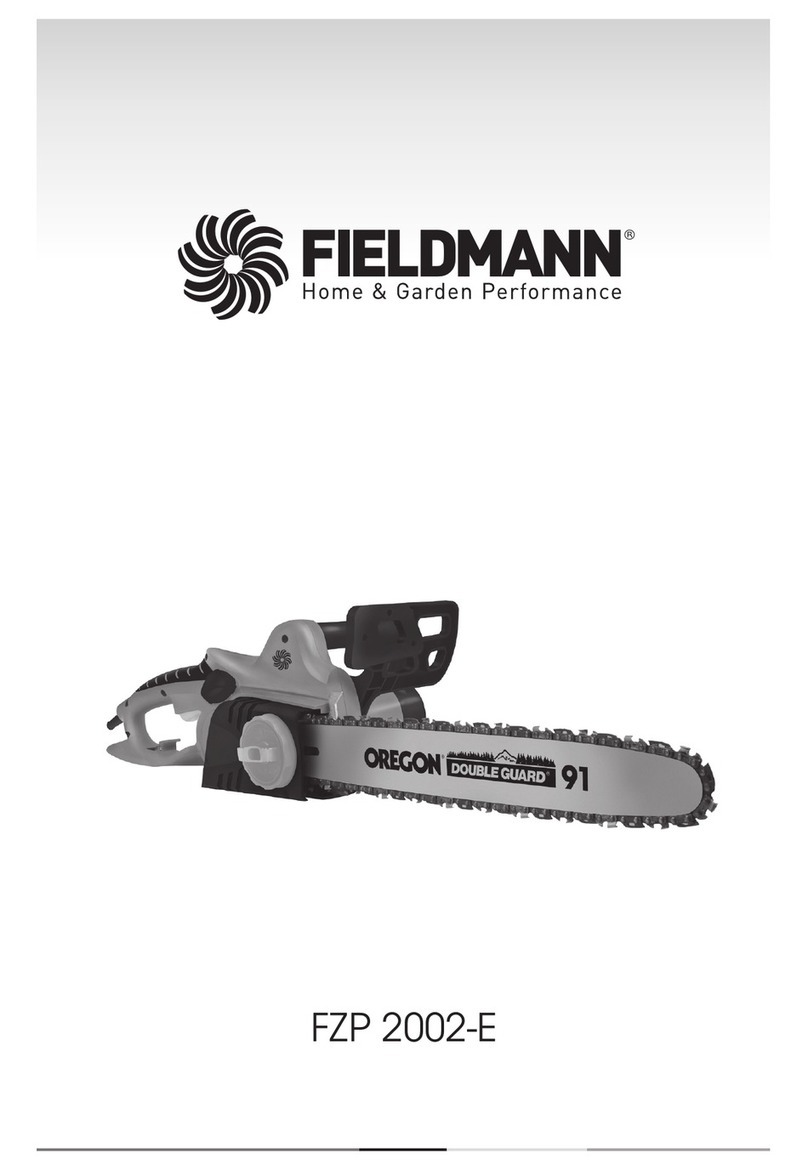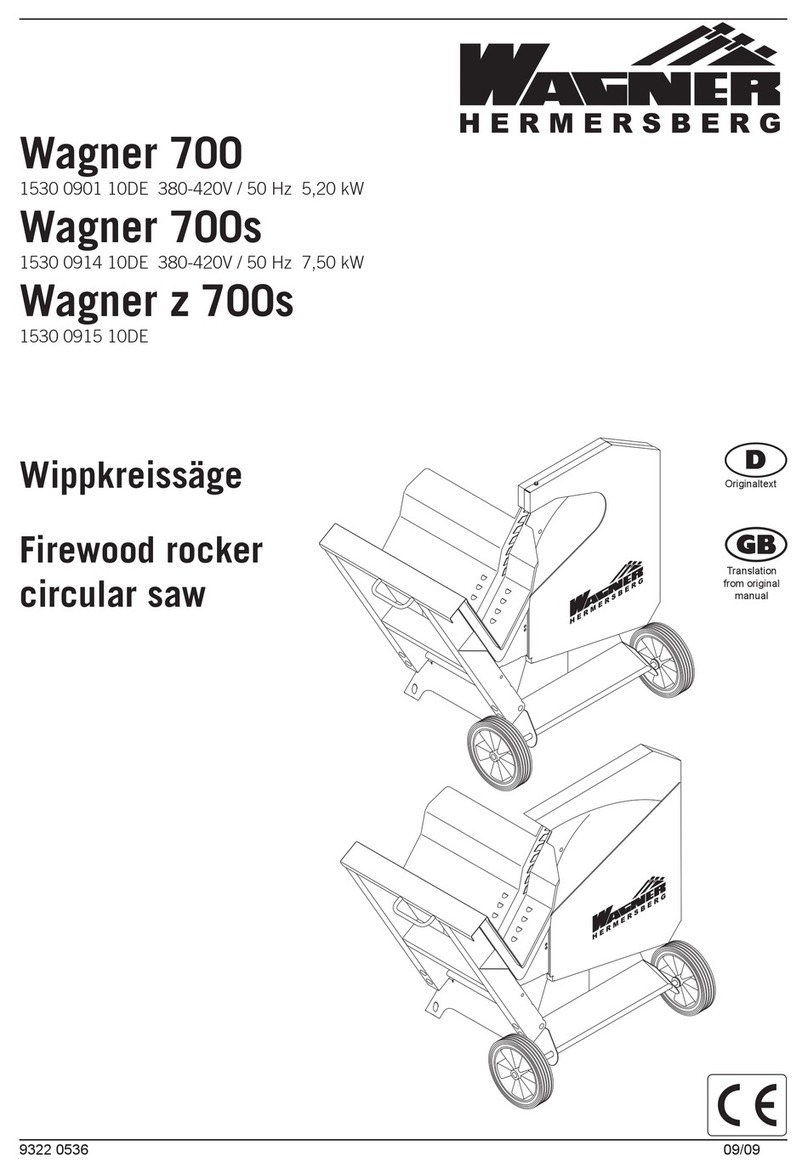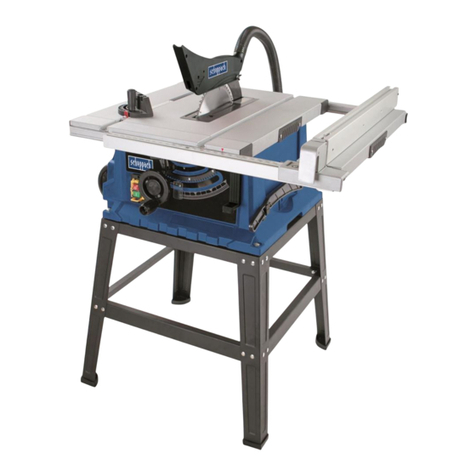Hilti WSG 7.25-5 User manual


ORIG I]{At O PERATI l{G I]{STRUGTIOI{S
Gircular Saw WSG 7.25-5
It is essential thatthe operating instructions
are read before the tool is operated tor the
tirctIime.
Always keep these operating instructions
together with the tool.
Ensure that the operating instructions
are with the toolwhen it is given to olher
percons.
Conlents
1. Soecifications
2. General PowerTool SafetvWarnings 1
3. Safetv Instructions forall saws 2
4. Further Safety lnstructions for all saws 3
5. Safety Instructions for Saws with Pendulum
Guard 4
6. Savethese Instructions 5
7. Svmbols
8. Functional Descriotion
9. Assemblv
10. 0peration 8
1 1. Maintenance 9
'12. Accessories 10
13. Manufacturer's warrantv - t00ls 10
-I
re IlIr
Blade diameter 185 mm (7-114 )
at 0' 62.5 mm (2-7116'\
Max. Cutting depth at45' 43.5 mm (1-11116")
at 56' 32.5 mm (1-1l4")
No load soeed (RPM) 5.800/min.
Overall lenoth 317 mm n21l2r\
Net weioht 5.2 ko (1 1-112 lbs)
. Due to our continuing program of research and
development, the specifications herein are subject
to change without notice.
. Specifications may differ from country to country.
. Weight according to EPTA-Procedure 01/2003
tal
'lxi WARNING Read all salety wamings and all instruc-
tions. Failure to follow the warnings and instructions
may result in electric shock, fire and/or serious injury.
Save all warnings and inskuctions lor futute telerence
The term "power tool" in the warnings refers to your
mains-operated (corded) powertool or battery-operat-
ed (cordless) powertool.
1.1 Work area salely
a) Keep work area clean and well lit. Cluttered or dark
areas invite accidents.
b) Do not operale power tools in explosive atmos-
pheres, such as in lhe presence ol llammable liq-
uids, gases or dusl. Power tools create sparks which
may ignite the dust or fumes.
c) Keep children and bystanders away while operal-
ing a power tool. Distractions can cause you to lose
control.
2.2 ElectriEal satety
a) Power lool plugs musl match the outlel. Never mod-
ity the plug in any way. Do nol use any adapter plugs
with earthed (grounded) power lools. Unmodified
plugs and matching outlets will reduce risk of elec-
tric shock.
b) Avoid body contact with earthed or grounded sur-
faces such as pipes, radialors, ranges and relrig-
erators. There is an increased risk of electric shock
if your body is eafihed or grounded.
c) Do not expose p0wer l00ls t0 rain or wet condilions.
Water entering a power tool will increase the risk of
electric shock.

d) Do not abuse the cord. Never use lhe cord for car-
rying, pulling or unplugging the power tool. Keep
cord away from heat, oil, sharp edges or moving
pads. Damaged or entangled cords increase the risk
of electric shock.
I e) When operaling a power tool 0uld00rs, use an exlen-
Ell sion cord suitable for ouldoor use. Use of a cord
suitable for outdoor use reduces the risk of electric
shock.
f) ll operating a power lool in a damp location is
unavoidable, use a ground lault circuit interupter
(GFCI) prolected supply. Use of a GFCI reduces the
risk of electric shock.
2.3 Penonal salety
a) Stay alert, watch what you are doing and use com-
mon sense when operating a power tool. Do not use
a power tool while you are tired or under the influ-
ence of drugs, alcohol or medication. A moment of
inattention while operating power tools may result in
serious oersonal iniurv.
b) Use perional protictive equipment. Always wear
eye protecti0n. Protective equipment such as dust
mask, non-skid safety shoes, hard hat, or hearing
protection used for appropriate conditions will reduce
personal injuries.
c) Prevent unintentional starting. Ensure the switch
is in the ofFposition belore connecling lo power
source and/or battery pack, picking up ol carrying
the tool. Carrying power tools with your finger on the
switch or energising power t00ls that have the switch
on invites accidents.
d) Remove any adjusting key or wlench belore turn-
ing the power tool on. A wrench or a key left attached
t0 a rotating pafi of the power tool may result in per-
sonal injury.
e) Do nol overreach. Keep properfooling and balance
at all times. This enables better control of the oow-
er tool in unexoected situations.
f) Dress properly. Do not wear loose clolhing or jew-
ellery. Keep your hair, clothing, and gloves away
from moving pads. Loose clothes, jewellery or long
hair can be caught in moving parts.
g) lf devices are provided lor the conneclion of dust
extlaGli0n and colleclion facilities. ensure these
tt
a) /Al DANGER: Keep hands away lrom cutting area
and the blade. Keep your second hand on auxiliary
handle, or motor housing. lf both hands are holding
the saw, they cannot be cut by the blade.
b) 0o not reach underneath the workpiece.
cannot protect you from the blade below
piece.
are connected and properly used. Use of dust col-
lection can reduce dust-related hazards.
2.4 Power tool use and carg
a) Do nol force the power lool. Use the correct power
tool for your application. The correct power tool will
do the job better and safer at the rate for which it was
designed.
b) Do nol use the powel lool il the switch does not turn
it on and off. Any power tool that cannot be controlled
with the switch is dangerous and must be repaired.
c) Disconnecl the plug lrom lhe powel source and/or
lhe batlery pack from the power tool belore mak-
ing any adjustments, changing accessories, or stor-
ing power tools. Such preventive safety measures
reduce the risk of starting the power tool accidentally.
d) Slore idle power tools out ol the reach of children
and do not allow persons unfamiliar wilh the pow-
er tool or lhese instructions t0 operale lhe power
tool. Power tools are dangerous in the hands of
untrained users.
e) Mainlain power lools. Check lor misalignment 0r
binding ol moving parts, breakage of parts and any
olhel condition lhat may atfect lhe power tool's oper-
ation. lf damaged, have lhe power tool repaired
before use. Many accidents are caused by poorly
maintained oower tools.
f) Keep cutting tools shary and clean. Properly main-
tained cutting tools with sharp cutting edges are less
likely to bind and are easier to control.
g) Use the power tool, accessories and lool bits etc.
in accordance with these instructions, taking into
accounl the working conditions and the work to be
performed. Use of the power tool for operations dit
ferent from those intended could result in a hzardous
situation.
2.5 Service
a) Have your power tool serviced by a qualified repair
person using only identical replacement pafis. This
will ensure that the safety of the power tool is main-
tained.
The guard
the work-
c) Adiust lhe cutling depth l0 the thickness ol lhe wodr-
piece. Less than a full tooth of the blade teeth should
be visible below the workoiece.
d) Never hold piece being cul in your hands 0r acloss
your leg. Secure the workpiece l0 slable plalform.
It is important to support the work properly to mini-
mize body exposure, blade binding, or loss of con-
trol.

A typical illustration of proper hand support, workpiece
support, and supply cord routing (if applicable). g) Always use blades with conect size and shape (dia-
mond versus round) of arbour holes. Blades that do
not match the mounting hardware of the saw will run
eccentrically, causing loss of control.
h) Never use damaged or incorrect blade washers or
boll. The blade washers and b0lt were specially
designed for your saw, for optimum performance and
safety of operation.
e) Hold power lool by insulaled gripping surlaces when
peiloming an operation where the cutling tool may
contact hidden wiring 0r its own cord. Contact with
a "live" wire will also make exposed metal parts of the
power tool "live" and shock the ooerator.
f) When ripping always use a rip fence or straight edge
guide. This improves the accuracy of cut and reduces
the chance of blade bindino.
a) Causes and 0perator Prevention of Kickback:
- kickback is a sudden reaction to a pinched, bound
or misaligned saw blade, causing an uncontrolled
saw to lift uo and out of the workoiece toward the
00eralor:
- when the blade is pinched or bound tightly by the
kerf closing down, the blade stalls and the motor
reaction drives the unit rapidly back toward the oper-
at0r;
- if the blade becomes twisted or misaligned in the
cut, the teeth at the back edge of the blade can dig
into the top surface of the wood causing the blade
to climb out of the kerf and jump back toward the
0peralor.
Kickback is the result of saw misuse and/or incorrect
operating procedures 0r conditions and can be avoid-
ed by taking proper precautions as given below:
1. Maintain a firm grip with both hands on lhe saw
and p0sition y0ur alms t0 resisl kickback forces.
Position your body to either side of the blade, but
not in line with the blade. Kickback could cause
the saw to jump backwards, but kickback forces
can be controlled by the operator, if proper pre-
cautions are taken.
2. When blade is binding, or when interrupling a
cut lor any reason, release lhe trigger and hold
the saw motionless in the material until the blade
comes t0 a complete stop. Nevel attempt to remove
the saw lrom the work or pull lhe saw backward
while the blade is in motion or kickback may
occur. Investigate and take corrective actions to
eliminate the cause 0f blade binding.
3. When restarling a saw in the workpiece, centre
the saw blade in the kerl and check thal saw teeth
are not engaged inlo the material. lf saw blade is
binding, it may walk up or kickback f rom the work-
oiece as the saw is restafted.
4. Support large panels to minimise the ilsk of blade
pinching and kickback. Large panels tend to sag
under their own weight. Supports must be placed
under the panel 0n both sides, near the line of cut
and near the edge of the panel.
To avoid kickback, do support board or panel near the
cur.
D0 not support board or panel away from the cut.

5. Do nol use dull or damaged blades. Unsharpened
or improperly set blades produce nanow kerf caus-
ing excessive friction, blade binding and kickback.
6. Blade depth and bevel adjusting locking levers
must be lighl and secure belore making cut. lf
blade adjustment shifts while cutting, it may cause
binding and kickback.
7. Use extra caulion when making a "plunge cut"
into existing walls or other blind areas. The pro-
truding blade may cut obiects that can cause kick-
back.
a) Gheck lower guard lor proper closing before each
use. Do not operate the saw if lower guard does not
move freely and close inslanlly. Never clamp or lie
the lower guard into lhe open posilion. lf saw is acci-
dentally dropped, lower guard may be bent. Raise the
lower guard with the retracting handle and make sure
it moves freely and does not touch the blade or any
other part, in all angles and depths of cut.
b) Check the operation ol the lower guard spring. lf
the guard and the spring are not operating propel-
ly, they must be serviced belore use. Lower guard
may operate sluggishly due to damaged parts, gum-
my deposits, or a build-up of debris.
c) Lower guard should be retracted manually only for
special culs such as "plunge cuts" and "compound
cuts." Raise lower guard by retracting handle and
as soon as blade enters the malerial, the lower
guard must be released. For all other sawing, the
lower guard should operate automatically.
d) Always observe thal the lower guard is covering the
blade before placing saw down on bench or floor.
An unprotected, coasting blade will cause the saw to
walk backwards, cutting whatever is in its path. Be
aware of the time it takes for the blade to stop after
switch is released.
e) ALWAYS hold the toollirmly wilh both hands. NEV'
ER place your hand or lingers behind the saw. lf
kickback occurs, the saw could easily jump back-
wards over your hand, leading to serious personal
injury.
fl Never lorce the saw. Push the saw forward at a
speed so that the blade cuts wilhout slowing. Forc-
ing the saw can cause uneven cuts, loss of accuracy,
and oossible kickback.
g) Use extra caulion when cutting damp wood, pres-
sure treated lumber, or wood conlaining knots.
Adjust speed 0f cut t0 maintain smooth advancement
of tool without decrease in blade speed.
h) Do not attempt to remove cut malerial when blade
is moving. Wail until blade stops before grasping
cut material. CAUTI0N: Blades coast after turn off.
i) Avoid Cutting Nails. Inspect for and remoue all nails
from lumbel before cutling.
j) Place the wider portion ol the saw base 0n that pan
ol the workpiece which is solidly supported, nol on
the section that will fall oll when the cut is made.
As examples, Fig. 1 illuslrates the RIGHT way to
cut ofl the end of a board, and Fig. 2 the WROllG
way. lf the workpiece is shori or small, clamp il
down. D0 NOT TRY T0 H0LD SH0BT PIECES BY
HAND!
k) Before setling the tool down after completing a cut,
be sure that the lower guard has closed and the
blade has come to a complete stop.

l) Never attempt t0 saw wilh the circular saw held
upside down in a vise. This is extremely danger-
ous and can lead to serious accidents.
m) Some material contains chemicals which may be
loxic. Take caution t0 prevent dusl inhalalion and
skin contacl. Follow material supplier sately data.
n) Do nol stop the blades by lateral pressure on the
saw blade.
o) Always use blades recommended in this manual,
Do not use any abrasive wheels.
p) Keep blade sharp and clean. Gum and wood pitch
hardened on blades slows saw and increases ooten-
tial for kickback. Keep blade clean by first removing
it from tool, then cleaning it with gum and pitch remover,
hot water or kerosene. Never use oasoline.
o)lflji;,lttt task and hearins protection when use !il
r) Follow instruction lor lubricaling and changing
accessories.
s) Keep handls dry clean and lrce fiom oil and grcase.
USE PR0PER EX|ENSI0N C0RD. Make sure your exten-
sion cord is in good condition. When using an exten-
sion cord, be sure to use one heavy enough to carry the
current your product will draw. An undersized cord will
cause a drop in line voltage resulting in loss of power
and overheating. Table 1 shows the correct size t0 use
depending 0n cord length and nameplate ampere rat-
ing. lf in doubt, use the next heavier gage. The smaller
the gage number, the heavier the cord.
mt
IANIWARNING:
D0 NOT let comforl or familiarity with product (gained
from repealed use) replace sllict adherence to safe-
ty rules lor the subiect product. MISUSE or failure to
follow the salety rules staled in this inslruction man-
ual may cause seilous personal injury.
a--l
]ZSJWARNING:
Some dust created by grinding, sanding, cutting, and
drilling contains chemicals known to cause Gancer,
birth defects, infefiility or other reproductive harm; or
selious and pelmanent respiratory or other injury.
Some examples of these chemicals are:
. lead from lead-based paints,
. crystalline silica from bricks, concrete and other mason-
ry products and natural stone,
. arsenic and chromium from chemicallv-treated lum-
0er.
Your risk from these exposures varies, depending on
how often you do this type of work. To reduce exposure
to these chemicals, the operalor and byslanden should
wo* in a well-ventilated alea, work wilh approved
salety equipmenl, such as respiratory prolection appro-
priate lor the type of dust generated, and designed to
filter out microscopic paflicles and direcl dust away
from the face and body. Avoid prolonged contact with
dusl. War proteclive clolhing and wash exposed areas
with soap and water. Allowing dust t0 get into your
mouth, eyes, or to remain on your skin may promote
absorotion of harmful chemicals.
Table 1:Minimum
Ampere Rating Volts Total
120 V25ft. 50 ft. 1 00 ft. 1 50 ft.
Not More Than AWG
b18 to 16 14
10 18 16 14
IU 12 16 16 14 1
ta 16 14 12

The followings show the symbols used for tool.
EX . volts
. amperes
. hertz
. alternating current
no . no load speed
Hz
F./,
E . Class ll Construction
.../min
fTmin . revolutions or reciprocation per minute
/l\I
z_trlcAUTl0N:
. Always be sure that the tool is switched off and unplugged
before adjusting or checking function on the tool.
Adiusling deplh of cut
2 1. Lever
2. Depth guide
ll\isauflsx.
. After adjusting the depth of cut, always tighten the lever
securely.
Loosen the lever on the depth guide and move the base
up or down. At the desired depth of cut, secure the base
by tightening the lever.
For cleaner, safer cuts, set cut depth s0 that n0 more
than one blade tooth projects below workpiece. Using
proper cut depth helps to reduce potential for danger-
ous KICKBACKS which can cause personal injury.
Eevel cutting
Positive stopper
Turn the positive stopper so that the arrow on it points
one of three positi0ns (22.5',45',56'). Then, tilt the tool
base until it stoos and secure the base with the lever. At
this time, the same angle as the one that the arrow points
is obtained.
Setting bevel angle
Loosen the lever and tentatively set the tool base at the
0"bevel angle, then tighten the lever securely.
Turn the positive stopper so that the arrow on it points
one of three positions (22.5',45",56') that is equal to
or greater than the desired bevel angle.
Loosen the lever again and then tilt and secure the tool
base at the desired angle securely.
NOTE:
. When changing the positive stopper's position, loos-
ening the lever and tilting the bevel angle t0 less than
the desired stopper position number allows to change
rt.
. When the arrow on the positive stopper points 22.5,
the bevel angle can be adjusted 0 - 22.5';when the
arrow points 45, it can be adjusted 0 - 45"; when the
arrow points 56, it can be adjusted 0 - 56'.
Sighling
1. Lever
2. Positive
stopper
3. Arrow on
positive
sr0pper
For straight cuts, align the A position on the front of the
base with your cutting line. For 45' bevel cuts, align the
B oosition with it.

Switch action
1. Switch Viggel
mt
lz--\/cAuTt0N:
. Before plugging in the tool, always check to see that
the switch trigger actuates properly and returns t0 the
"0FF' oosition when released.
To start the t001, simply pull the switch trigger. Release
the switch trigger to stop.
Electric brake
This tool is equipped with an electric blade brake. lf the
tool consistently fails to quickly stop blade after switch
trigger release, have t00l serviced at a Hilti service cen-
ter.
The blade brake system is not a substitute for lower
guard. NEVER USE T00L WITHOUT A FUNCTI0NING
LOWER GUARD. SERIOUS PERSONAL INJURY CAN
RESULT.
Lighting the lamp
'1. Lamp
]/i\
lz-.-r cAlJTl0N:
. Do not apply impact to the lamp, which may cause
damage or shorted service time t0 it.
. Do not look in the light or see the source of light directly.
The lamp lights up when the tool is plugged. The lamp
keeps on lighting until the tool is unplugged.
lf the lamp does not light up, the mains cord may be
defective. The lamp is lit but the tool does n0t start even
if the tool is switched on, the carbon brushes may be
worn out, the m0t0r orthe 0N/0FF switch may be defec-
tive.
NOTE:
. Use a dry cloth to wipe the dirt off the lens of lamp. Be
careful not t0 scratch the lens of lamp, or it may low-
er the illumination.
f-t
Lr=-}l cAUTlON:
. Ah^ays be sure that the tool is switched off and unplugged
before carrying out any work on the to0l.
Hex wrench storage
1. Hex wrench
2. Protrusion
Hex wrench is stored on the tool. To remove hex wrench,
rotate it toward yourself and pull it out.
To install hex wrench, place it on the handle and turn it
until it comes into contact with the orotrusion on the
handle.
Removing or installing saw blade
1. Hex wrench
2. Shaft lock
GAUTIOl,I:
. Be sure the blade is installed with teeth pointing up at
the front of the tool.
. Use only the Hilti wrench to install or remove the blade.
To remove the blade. oress the shaft lock so that the
blade cannot revolve and use the hex wrench to loosen
the hex bolt counterclockwise. Then remove the hex bolt,
outer flange and blade.
To install the blade, follow the removal procedure in

1. Hex bolt
2. 0uter
flange
3. Saw blade
4. lnner
llange
5. Ring
TEVETSE. BE SURE TO TIGHTEN THE HEX BOLT CLOCK-
WISE SECURELY. When changing blade, make sure to also clean upper
and lower blade guards of accumulated sawdust. Such
efforts do not, however, replace the need to check low-
er guard operation before each use.
. Be sure to move the tool forward in a straight line gen-
tly. Forcing 0r twisting the tool will result in overheat-
ing the motor and dangerous kickback, possibly caus-
ing severe injury.
1. Base
2. Rear handle
3. Front grip
Hold the tool firmly. The tool is provided with both a front
grip and rear handle. Use both to best grasp the tool. lf
both hands are holding saw, they cannot be cut by the
blade. Set the base 0n the workoiece to be cut without
the blade making any contact. Then turn the tool 0n and
wait until the blade attains full speed. Now simply move
the tool forward over the workpiece surface, keeping it
flat and advancing smoothly until the sawing is com-
oleted.
To get clean cuts, keep your sawing line straight and
your speed of advance uniform. lf the cut fails to prop-
erly follow your intended cut line, do not attempt to turn
or force the tool back to the cut line. Doing so may bind
the blade and lead t0 dangerous kickback and possible
serious inlury. Release switch, wait lor blade to stop and
then withdrawtool. Realign tool on new cut line, and
start cut again. Attempt to avoid positioning which expos-
es operator to chips and wood dust being ejected from
saw. Use eye protection to help avoid injury.
Rip fence (Guide rule)
l. Rip fence
(Guide rule)
The handy rip fence allows you t0 do extra-accurate
straight cuts. Simply slide the rip fence up snugly against
the side of the workpiece and secure it in position with
the screw on the front of the base. lt also makes repeat-
ed cuts of uniform width possible.
CAUTION:

|^t
IAN CAUTION:
. Always be sure that the tool is switched ofi and unplugged
before attempting to perlorm inspection or mainte-
nance.
. Never use gasoline, benzine, thinner, alcohol or the
like. Discoloration, deformation or cracks may result.
Adiusting for accuracy of 90' cut (veilical cut)
This adjustment has been made at the factory. But if it
is off, adjust the adjusting screw with a hex wrench while
squaring the blade with the base using a triangular rule,
try square, etc.
1 . Base
2. Adjusting
screw
1. Triangular
rule
Replacing caft on brushes
1. Limit mark
Remove and check the carbon brushes regularly. Replace
when they wear down to the limit mark. Keep the car-
bon brushes clean and free to slio in the holders. Both
carbon brushes should be replaced at the same time.
Use only identical carbon brushes.
Use a screwdriver to remove the brush holder caos. Take
out the worn carbon brushes, insert the new ones and
secure the brush holder caos.
1. Brush
holder cap
2. Screw-
dnver
After replacing brushes, plug in the tool and break in
brushes by running tool with no load for about 10 min-
utes. Then check the tool while running and electric brake
operation when releasing the switch trigger. lf electric
brake is not working well, ask your local Hilti service
center for reoair.
To maintain product SAFEW and RELIABILIft repairs,
any other maintenance or adjustment should be per-
formed by Hilti Authorized or Factory Service Centers,
always using Hilti replacement parts.

m
t{-$t cAUTloN:
. These accessories or attachments are recommended
for use with your Hilti tool specified in this manual. The
use of any other accessories or attachments might pre-
sent a risk of injury to persons. Only use accessory or
attachment for its stated purpose.
lf you need any assistance for more details regarding
these access0ries, ask your local Hilti Service Center.
. Steel & Carbide-tipped saw blades
Combination General purpose blade for fast and
smooth rip, crosscuts and miters.
Pressure treated/ Designed for fast cutting of
Wet lumber pressure treated and wet lumber.
Fine cross cuts For sand-free cuts cleanly against
+h^ ^.^i^
iltt utdilt.
. Rip fence (Guide rule)
. Hex wrench
Hilti warrants that the tool supplied is free of defects
in material and workmanship. This warranty is valid so
long as the tool is operated and handled correctly,
cleaned and serviced properly and in accordance with
the Hilti 0perating Instructions, and the technical sys-
tem is maintained. This means that only original Hilti
consumables, comp0nents and spare parts may be
used in the tool.
This warranty provides the free-of-charge repair or
replacement of defective parts only over the entire lifes-
pan o{ the tool. Parts requiring repair or replacement
as a result of normal wear and tear are not covered bv
this warranty.
Additional claims are excluded, unless stringenl
national rules prohibit such exclusion. In particulal,
Hilti is not obligaled for direct, indirect, incidental
or consequenlial damages, losses or expenses in
connection with, or by reason 01, the use 0f, 0r inabil-
ity to use the tool for any purpose. lmplied warranlies
of melchantabilig or fitness for a particular purpose
are specifically excluded.
For repair or replacement, send tool or related parts
immediately upon discovery of the defect to the address
of the local Hilti marketing organization provided.
This constitutes Hilti's entire obligation with regard to
warranty and supersedes all prior 0r contemporane-
0us comments and 0ral or written a0reements c0n-
cerning warranties.
Table of contents
Other Hilti Saw manuals
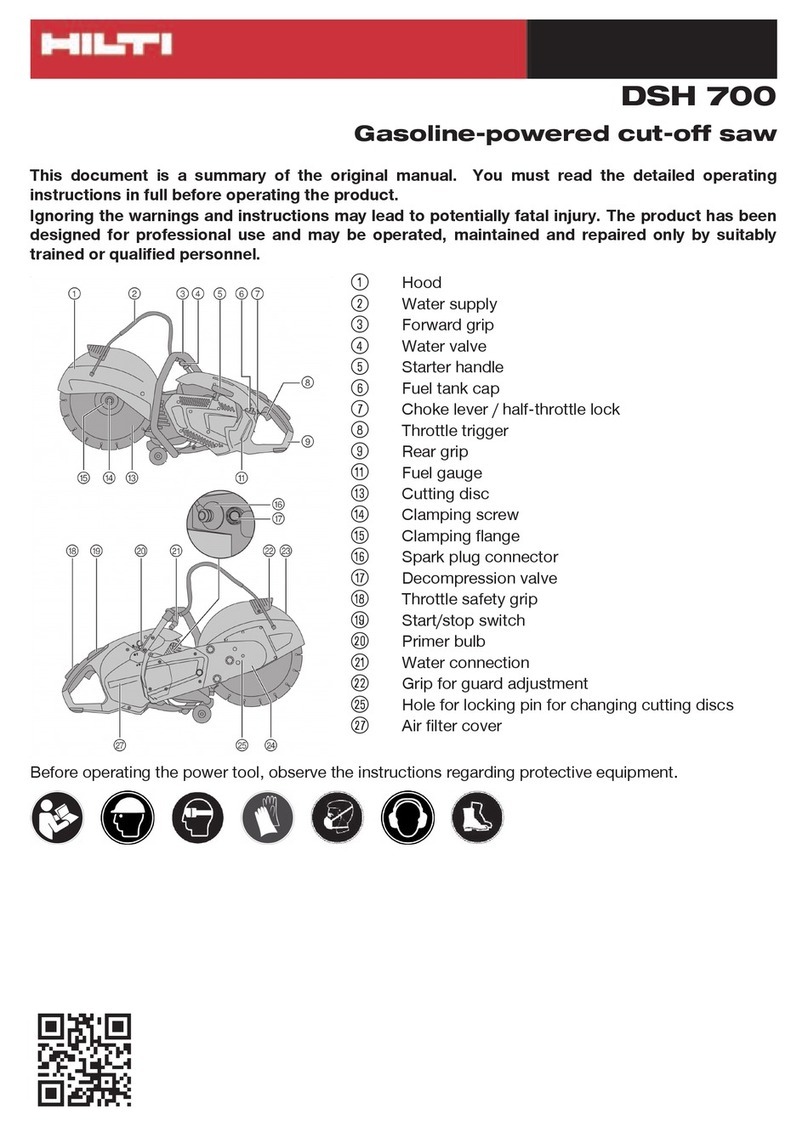
Hilti
Hilti DSH 700 Manual

Hilti
Hilti DSH 700-X User manual
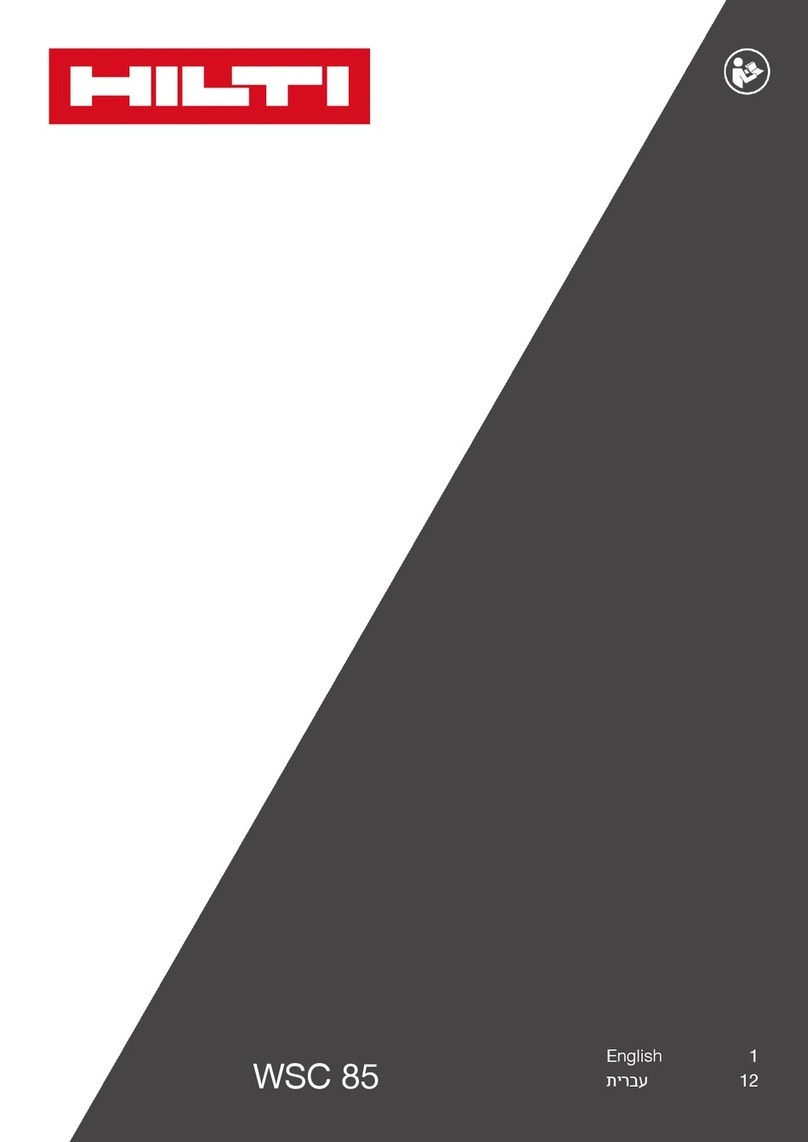
Hilti
Hilti WSC 85 User manual

Hilti
Hilti SR 30-A36 User manual

Hilti
Hilti WSC 7.25-S User manual
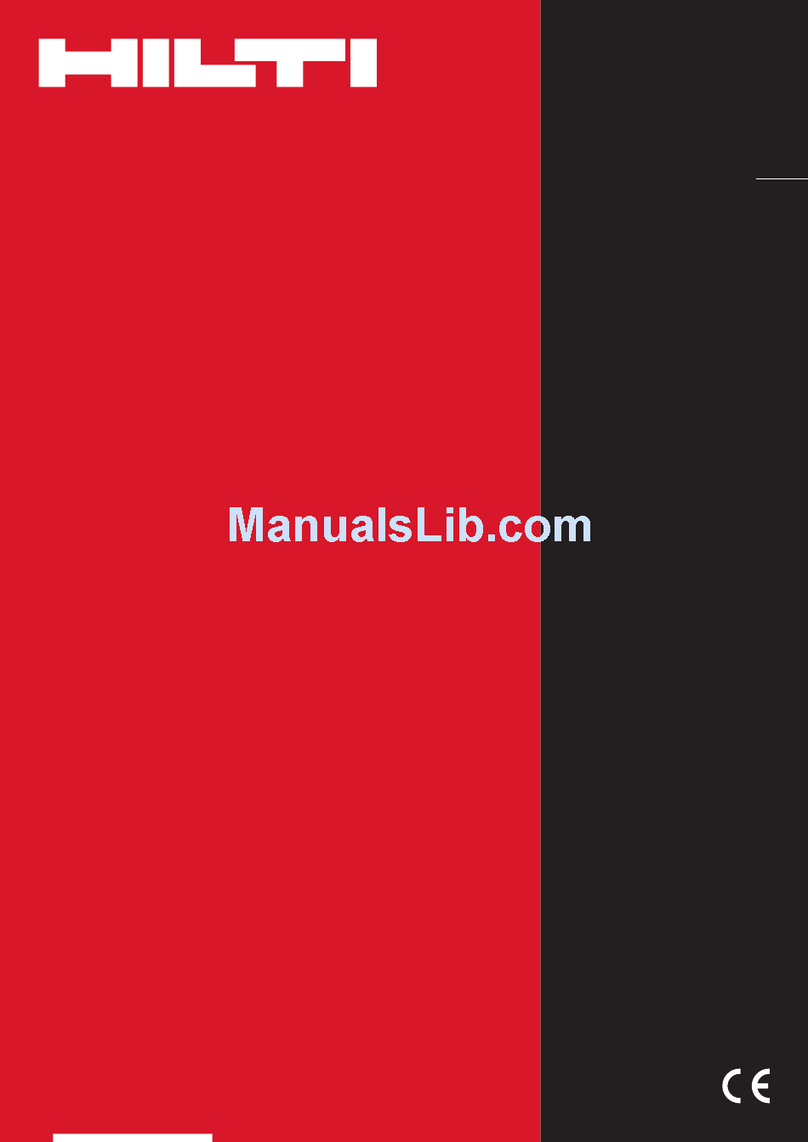
Hilti
Hilti DS-WSS 30 User manual

Hilti
Hilti DST 20-CA User manual
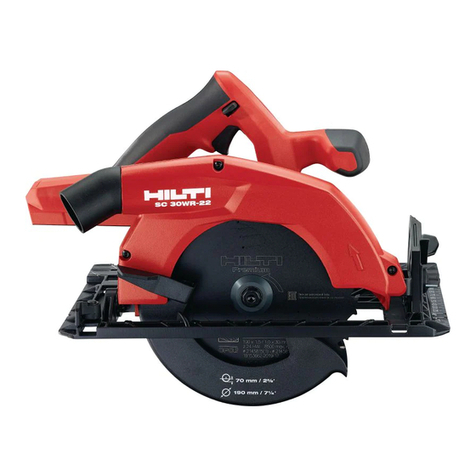
Hilti
Hilti Nuron SC 30WR-22 User manual

Hilti
Hilti Nuron DSH 600-22 User manual
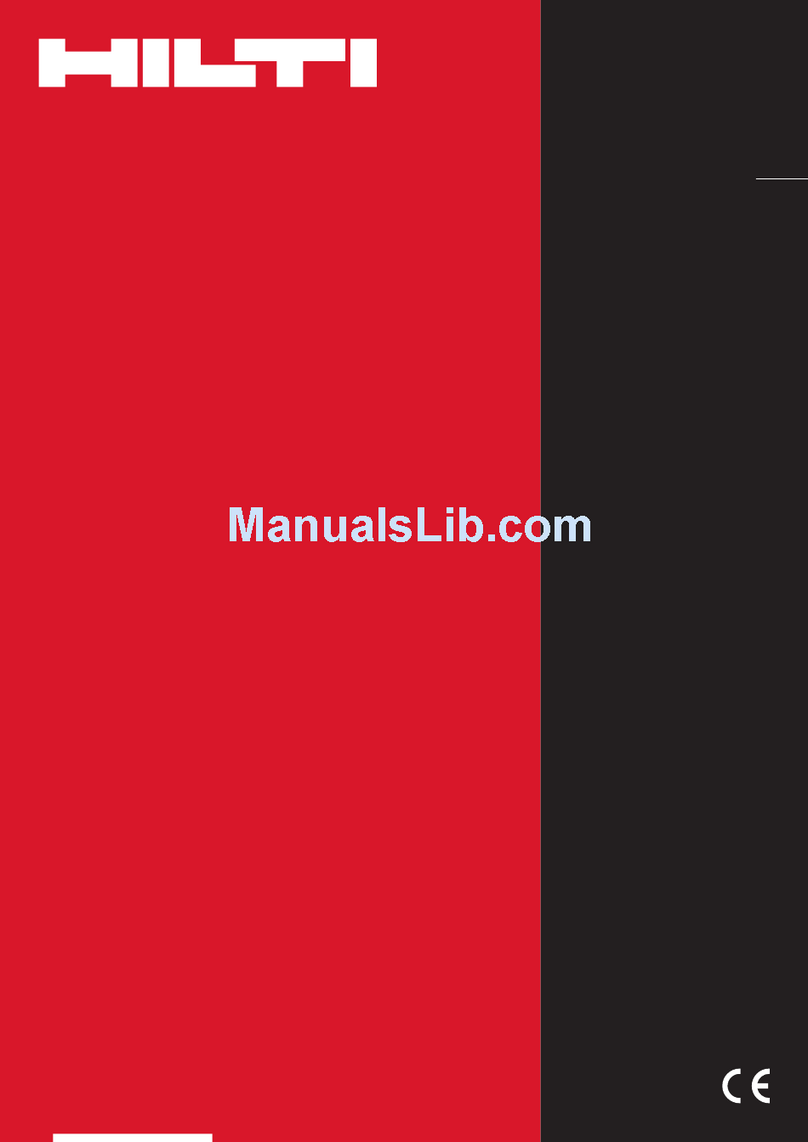
Hilti
Hilti DS WS10 User manual
